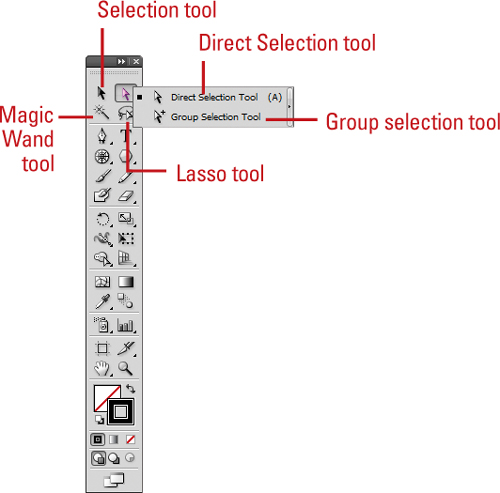1. Understanding Selections
When
you create vector graphics in Illustrator, they are comprised of
distinct segments that can be selected separately or as a whole with a
variety of selection tools. The type of editing you need to perform
determines which tool you use. For example, a simple rectangle is
comprised of four line segments that surround the contour of the shape
and one fill in the center. Each of these parts can be selected as a
group with the Selection tool or individually with the Direct Selection
tool. To select an object using the fill, you need to deselect the
Object Selection by Path Only check box in Selection & Anchor
Display preferences. If an object is behind another object, you can use
the keyboard shortcut  (Mac) or Ctrl+click (Win) to select it (New!). The pointer changes to an arrow with a small caret on the first
(Mac) or Ctrl+click (Win) to select it (New!). The pointer changes to an arrow with a small caret on the first  ;
as you continue to click the selection moves through the objects under
the pointer. To use this option, you need to select the Control Click to
Select Objects Behind check box in Selection & Anchor Display
preferences.
;
as you continue to click the selection moves through the objects under
the pointer. To use this option, you need to select the Control Click to
Select Objects Behind check box in Selection & Anchor Display
preferences.

In addition to the Selection and Direct Selection tools, you can also use the Group Selection
tool to select all the anchor points on a single path. With the Group
Selection tool, click to select an object, click twice to select the
object’s group, and click three times to select the group within the
group (if available). The Group Selection tool is useful for working
with multiple objects. If you want to work with an individual object
without affecting other objects, it’s better to use Isolation Mode.
The Lasso tool is a classic selection tool that allows you to select path points and segments by dragging a freeform marquee around them.
The Magic Wand tool allows you to select objects of the same or a similar fill color, stroke color, stroke weight, opacity, or blending mode.

2. Using the Selection Tool
There
are several ways to select objects in Illustrator. With the Selection
tool, you can select an object’s stroke or fill. You can only select an
object using the fill if the path appears in Preview mode, and the
Object Selection by Path Only check box is deselected in Selection &
Anchor Display preferences. After you select one or more objects, you
can add or subtract objects to/from the selection. In addition, you can
use the Selection tool and drag a marquee to select parts of the object
or drag over a portion of it to create a selection rectangle.
Select an Object with the Selection Tool
- 1. Click the Selection tool on the Tools panel.
The pointer becomes an arrow.
Timesaver
Press V to select the Selection tool.

- 2. Position the arrow on the edge of the object, and then click it.
- You can also drag a marquee across all or part of the object to select the entire path.
- If
the path has a color fill, appears in Preview mode, and the Object
Selection by Path Only check box is deselected in Selection & Anchor
Display preferences, you can also click the fill to select the object.

- 3. To add or subtract objects from the selection, hold down the Shift key,
and then click unselected objects to add or click selected objects to
subtract them from the selection.
